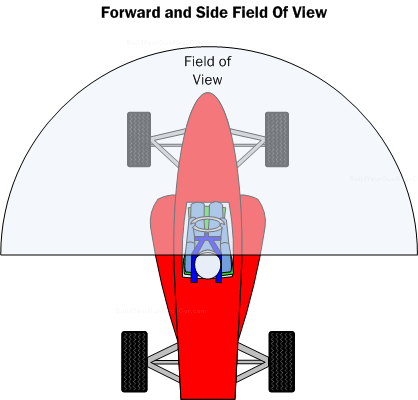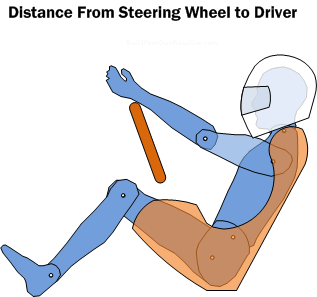
Car Driver Ergonomics Basics, How-To & Design Tips
Ergonomics, or the study of human-machine interfacing, is important to vehicle design because the ultimate control of the vehicle belongs to the driver. When designing this “interface” between person and machine, several aspects should be taken into account so that the best system of control is produced.
Seating Position/Field of View
A key input to the interface is the driver’s vision and that of any co-driver (i.e. Rally). The field of view, as shown in diagrams SP1 and SP2 below, should include visibility ahead and to the sides of the vehicle (Approximately 180 degree arc–more is even better) and visibility of the road surface.
The driver needs a sufficient level of information about the nature of the oncoming road surface and what is occurring beside them through peripheral vision to drive confidently. If the driver must strain their neck to see enough to feel confident, their field of view is inadequate.

Diagram SP1. Forward and side field of view should be at least 180 degrees. Even more is useful as the driver can turn their head slightly to pickup competitors in their peripheral vision.

Diagram SP2. Vertical field of view should permit the driver to see the road surface ahead with enough detail to gauge its condition. If the surface visible is too far away, resolution is lost and road condition can become vague.
The position the driver will sit in takes into account their field of view first and foremost. However, additional factors such as control positions, comfort and leg/arm leverage must also be factored in.
The design goals of the seating position are:
- To enable the driver (and co-driver) to see clearly ahead and beside themselves through standard and peripheral vision.
- To provide a position of comfortable leverage for the driver so they do not become tired due to operating the controls from an awkward position.
- To enable the driver to adequately see the side mirrors in their peripheral vision (At a minimum) so that the driver need not continuously take their eyes off the road ahead to gauge an opponent’s position behind them. Ideally the side mirrors should be far enough forward to enable direct viewing by a driver glancing at them.
- To enable easy visual access to gauges and other visual feedback in the forward looking line of sight.
- To minimize CG height to optimize handling.
Control Positions
Vehicle controls should be within a comfortable reach of the driver (and co-driver if applicable) and be comfortable to operate. Controls that are awkward to reach or difficult to operate will distract the driver/co-driver and potentially result in more driving mistakes.
Steering Wheel
The four most important aspects of the steering wheel are:
-
Distance from the driver – The steering wheel is a tool of leverage. As such, if the steering wheel is too close or too far away from the driver, they will find the steering awkward and tiring. As shown in diagram SW1 below, with their arm straight (but not straining), the driver should be able to rest their wrist on the top of the steering wheel. Doing so will ensure that in the worst case, the driver’s arms will not be locked straight while steering (Which is both uncomfortable and a poor leverage position)

Diagram SW1. Distance from driver to steering wheel. A general rule of thumb is that the driver’s wrist should sit on the top of the steering wheel with their arm straight and not reaching (Not extending their shoulder forward).
-
Elbow Room – When turning, one arm will be forced to move closer to the driver’s body. It is important to ensure that the seat does not interfere with that motion. If the driver is forced to keep his arms in a wing-like posture to avoid the seat or jam their elbow into their rib cage, it will be uncomfortable.
-
Steering Wheel Angle – The angle of the steering wheel goes hand in hand with points #1 and #2 above. The arc through which the steering wheel turns determines where the hands arms, and elbows will be located. To extreme an angle, horizontally or vertically will be uncomfortable.
-
Steering Wheel Size – Steering wheel size determines the amount of leverage but also the amount of motion required by the driver to turn the vehicle. The scrub radius of the steering tires/wheels, the steering rack ratio and the diameter of the steering wheel all contribute to the amount of movement and effort required to steer.
Ergonomics Tips (1/2)
Serve the driver
The vehicle cockpit should serve the driver, not the other way around. The more driver-friendly the ergonomics are, the more comfortable the driver will be and the better than can focus on driving.
Design in order
To design the cockpit, first establish a confident field of view. Next establish a seating position that is optimal for that field of view and the vehicle’s other design goals. Then, determine control positions and refine the overall cockpit through further iterations as needed.
Determining driver field of view
A helpful technique to achieve a good field of view is to use pieces of cardboard in place of vehicle structure (sides, hood), and gauge the driver’s comfort with their view. By adjusting the height of the pieces until the driver is comfortable and then taking measurements from the cardboard surfaces to the driver’s eyes, an assessment of the driver’s required head position can be made.
27 1 26 3

